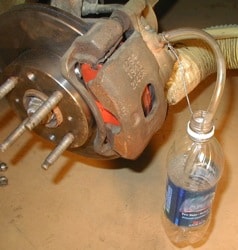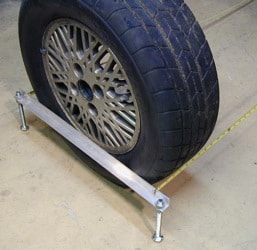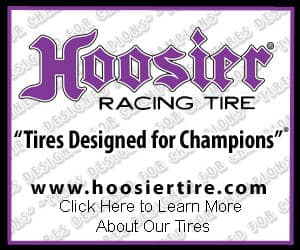
What are the Basic Tools that You will Need?
If you want to be able to work on your car, then you need the tools to do it. Just as a forewarning, while working on the car it is almost certain that you will come across projects that require special tools not often used and therefore not on this list. This is true especially because of the numerous different makes of vehicles. I admit it can become very frustrating having to stop in the middle of a project because you need to run out to a store to get a tool. There may be times when you are simply not aware that there is a tool made specifically for the task you are trying to complete. That said, the list below will provide you with the basic tools necessary for working on the racecar, and tow vehicle for that matter. With any luck you will already have some of these tools.
Basic Tool List:
- Tool box
- Metric or SAE socket and open wrench set (which depends on whether your racecar uses metric or English size bolts)
- Torque wrench (an inexpensive one works for most common applications)
- Wire stripper & crimping tool
- Spark plug gap tool

- Flashlight
- Mechanics gloves
- Jack (an inexpensive one will suffice)
- Jack stands
- Hand held jig saw to cut metal
- Tire pressure gauge
- Small mirror – No, it’s not a make up mirror – it is a Racer’s Mirror!
- Electric drill
- Drill bits
- Set of metal files
- Set of pliers
- Tin shears
- Screw driver set
- Set of adjustable wrenches
- Breaker bar (Two foot long “black iron pipe”). When you have a difficult bolt, use the pipe in conjunction with the breaker bar to obtain additional leverage. Be careful not to apply too much torque as it may snap the head off the bolt.
- Large rubber hammer
- Metal hammer (preferably a ball end, not a claw end)
- Large metal hammer (my favorite tool!)
- Pry bar
- Ball bearing fork
- Jumper cables
It seems that, no matter how many tools a racecar driver has, we always want more toys, I mean tools. There are some tools where a higher-end version would make things easier, such as a car lift, but these are not necessary if you are working on a budget. When looking at the many tools available, give thought to whether it really is a needed tool or just something that would be nice to have. I will use the racing jack as an example. Having a racing jack would be great, but during my past five years of racing I have “lived” with a standard (and inexpensive) jack. Be aware that if you start working on more advanced projects, such as engine building, you would need to purchase better quality tools, such as a more accurate torque wrench. Not that you need any help spending even more money, but here are a few tools that can make life easier and might be worth buying someday in the future.
- Portable air tank (to be used at the track for adding air to tires)
- Tire pyrometer (probe-type, not an infrared unit)
- Cordless impact wrench
- Racing jack
- Alignment tool for checking camber
- Alignment tool for checking toe
As with all other aspects of racing, keep your eyes and ears open for any opportunities where you can save yourself some money. Take a few minutes to think about where you might be able to get your tools cheaper. I admit that for many of these basic tools, it often is much easier to go to one store and purchase the tools. If you purchase bigger ticket items, it can’t hurt to look at eBay Motor’s tool section, tag or estate sales, and your newspaper’s classified advertisement section. For tools that you won’t use often, see if it is possible to borrow them from someone you know, or a fellow racer, or rent the tools. Another option to look into is the potential of borrowing tools from a local auto parts store. Many auto parts stores have tools set aside for do-it-yourself customers to borrow. Think of it this way, if they enable you to repair the car yourself, then they also increase their parts sales. One other piece of advice I’ll offer is to be creative with the tools that you have to accomplish the various maintenance / repairs. When you are at races, walk around the paddock and see what types of creative inventions and “tools” people are using. While you may not be saving what seems like a significant amount of money on each item, when the costs of all items are put together, it can provide a large cost savings.
Tool to Change Brake Fluid
 One example of economizing on tools is the tool used to change the car’s brake fluid. You could purchase a specialized brake bleeder tool, costing anywhere from $90 – $150. The one nice thing about some of those bleeder tools is that they allow you to change the brake fluid by yourself. Another solution is to use approximately a 12″ long plastic hose, piece of wire, and an empty 12 or 16 ounce plastic bottle. At one end of the wire, bend a loop large enough to fit over the brake bleeder valve. This is done so the unit can hang from the bleeder valve by itself. On the other end of the wire, wrap it around the top of the bottle, beneath where the cap would screw on. Once the assembled unit is hanging from the bleeder valve, put the correct size wrench on the bleeder screw. The next step is to insert the plastic tube over the bleeder valve and put the other side of the tube inside the plastic bottle. Now you are ready to begin bleeding the brakes. True, if you follow my lead, you will need an assistant to pump the brakes, but the tool will cost you less than $10.
One example of economizing on tools is the tool used to change the car’s brake fluid. You could purchase a specialized brake bleeder tool, costing anywhere from $90 – $150. The one nice thing about some of those bleeder tools is that they allow you to change the brake fluid by yourself. Another solution is to use approximately a 12″ long plastic hose, piece of wire, and an empty 12 or 16 ounce plastic bottle. At one end of the wire, bend a loop large enough to fit over the brake bleeder valve. This is done so the unit can hang from the bleeder valve by itself. On the other end of the wire, wrap it around the top of the bottle, beneath where the cap would screw on. Once the assembled unit is hanging from the bleeder valve, put the correct size wrench on the bleeder screw. The next step is to insert the plastic tube over the bleeder valve and put the other side of the tube inside the plastic bottle. Now you are ready to begin bleeding the brakes. True, if you follow my lead, you will need an assistant to pump the brakes, but the tool will cost you less than $10.
Basic Alignment Tool
 Another example to economize on tools is the tool used to check the vehicle’s toe alignment. You could go out and buy toe plates for approximately $55. The other option is to go to a hardware store and make your own toe alignment tool for about $15. Buy two metal bars that are at least 4″ longer than the tire’s diameter. (It is much easier to buy two longer pieces and cut them down to the size that meets your needs.) You will need someone else to assist you with the measuring process. Put the bar horizontally across the wheel and tire of both front wheels high enough to clear the tire bulge caused by the weight of the car. Try to get both bars at approximately equal heights. Using a measuring tape (or, if you want to be a bit more efficient, use two measuring tapes), measure the front distance between the two bars then the rear distance. When measuring these distances, make sure that both you and your helper have the bars firmly against the tire. In order to help with the measuring process, I cut two slots on each side of the bars to insert the measuring tape. You will need to pull the tape tight to avoid slack, which would throw the measurements off. If there are any items that interfere with taking the measurements beneath the car (such as brake duct hoses), you will need to modify the set-up a bit. To get toe out, the front measurements should be longer than the rear by the amount of desired toe. If it needs to be adjusted, you will need to adjust the tie rods to achieve the desired toe. To give you a ballpark figure, on many cars one complete rotation of the tie rod equals a change of approximately 1/16″ toe. If the car needs more then 1/16″ toe adjustment, I suggest that you try to do equal amounts on both sides of the car. Otherwise, your steering wheel may not be centered. Once you have completed the adjustment and tightened the tie rods, roll the car back and forth a few times, then re-measure the toe. While frustrating, it is pretty normal to accidentally adjust the toe the opposite way. After doing this one or twice, you will learn which way the tie rods need to be turned on your car to increase and decrease toe.
Another example to economize on tools is the tool used to check the vehicle’s toe alignment. You could go out and buy toe plates for approximately $55. The other option is to go to a hardware store and make your own toe alignment tool for about $15. Buy two metal bars that are at least 4″ longer than the tire’s diameter. (It is much easier to buy two longer pieces and cut them down to the size that meets your needs.) You will need someone else to assist you with the measuring process. Put the bar horizontally across the wheel and tire of both front wheels high enough to clear the tire bulge caused by the weight of the car. Try to get both bars at approximately equal heights. Using a measuring tape (or, if you want to be a bit more efficient, use two measuring tapes), measure the front distance between the two bars then the rear distance. When measuring these distances, make sure that both you and your helper have the bars firmly against the tire. In order to help with the measuring process, I cut two slots on each side of the bars to insert the measuring tape. You will need to pull the tape tight to avoid slack, which would throw the measurements off. If there are any items that interfere with taking the measurements beneath the car (such as brake duct hoses), you will need to modify the set-up a bit. To get toe out, the front measurements should be longer than the rear by the amount of desired toe. If it needs to be adjusted, you will need to adjust the tie rods to achieve the desired toe. To give you a ballpark figure, on many cars one complete rotation of the tie rod equals a change of approximately 1/16″ toe. If the car needs more then 1/16″ toe adjustment, I suggest that you try to do equal amounts on both sides of the car. Otherwise, your steering wheel may not be centered. Once you have completed the adjustment and tightened the tie rods, roll the car back and forth a few times, then re-measure the toe. While frustrating, it is pretty normal to accidentally adjust the toe the opposite way. After doing this one or twice, you will learn which way the tie rods need to be turned on your car to increase and decrease toe.
To measure camber, you will need a special tool to obtain the measurements. If you walk around the paddock at a race, ask very nicely, and possibly leave your wife and kids as collateral, you might find someone who will let you borrow their camber tool. If you decide to purchase a camber tool, anticipate paying approximately $130 for it. Of course, you could also bring the racecar to a garage for the alignment, but that would get very expensive over time (approximately $80 for each alignment).
By now you may be wondering, “What are the proper alignment settings?” There are no universal settings for all car types, tracks, and personal car driving preferences. I recommend that you speak with other experienced drivers at the tracks where you will be racing to obtain a starting point.
